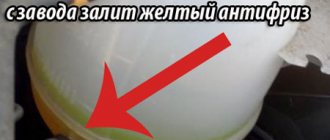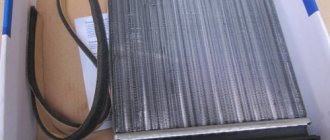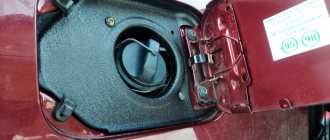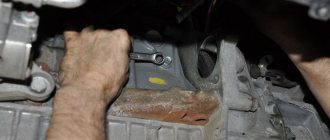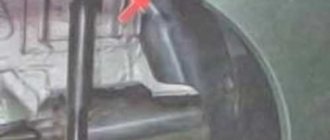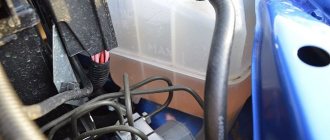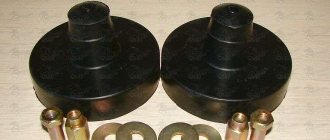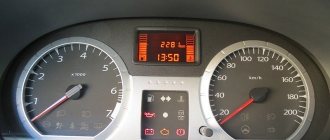Downloading a book
After successfully completing the payment (by any method) and returning to the KrutilVertel store from the payment system website, you will be taken to the successful payment page:
The book you purchased will be in your personal account, from where you can always download it.
Please note that after making the payment, you need to return back from the payment system website to the KrutilVertel website. If for some reason you did not return back to the site and closed the payment system tab with a message about the successful completion of the payment, please let us know - we will send you a letter indicating access to download the book
If for some reason you did not return back to the site and closed the payment system tab with a message about the successful completion of the payment, please let us know - we will send you a letter indicating access to download the book.
Draining and replacing antifreeze on Largus
There are two types of internal combustion engines installed on the Lada: 8 valves and 16 valves. They have no fundamental difference in the cooling system, and therefore replacing the coolant is carried out in the same way on any of them. All work is carried out only on a cooled engine.
The procedure for draining waste fluid is simple and looks like this:
- unscrew the cap of the expansion tank Lada Largus;
- remove the metal crankcase protection (if any);
- Structurally, the manufacturer did not provide drain plugs on the cylinder block and on the radiator, so the liquid will have to be drained by loosening the lower clamps and squeezing them with pliers;
- under the radiator you should place a container capable of holding at least six liters;
- at the initial stage, it is better to tighten the cap of the expansion tank - this way antifreeze will not flow out after the lower radiator hose is disconnected, then you can gradually open the cap;
- after the liquid stops draining into the container, the pipe is put into place and secured with a clamp.
If possible, avoid contact of fluid with engine components. And also with mucous membranes and skin, because due to the chemical composition, antifreeze can cause chemical burns. And if you don’t let it cool down, then it’s thermal.
Flushing the cooling system
Sometimes it may be necessary to flush the SOD, especially when the refrigerant contains impurities, dirt, etc. For these purposes, you can use either ordinary distilled water or special flushing liquids. The operating algorithm is simple. After draining the liquid, you need to fill in water instead of new antifreeze and start the engine, letting it idle for 10–15 minutes until it reaches operating temperature, passing the liquid through a large circulation circle. Next, turn off the engine and wait until the water or flushing fluid cools down. After this, it can be drained and, depending on the result of washing, either repeat the procedure or fill in a new composition.
Replacing antifreeze
Every motorist can perform this procedure on a Lada Largus car with his own hands; for this it is not necessary to resort to the help of specialists. The algorithm of actions is simple and looks like this:
- The car is installed above an inspection hole or on an overpass.
- The procedure for draining antifreeze from the system is repeated in the above manner.
- Before filling in new antifreeze, the protective cap must be removed from the fitting on the coolant supply hose to the heater;
- Pour liquid into the expansion tank and continue until a smooth stream without air bubbles comes out of the fitting.
- Close the fitting cap and fill in antifreeze to the maximum mark of the expansion tank.
- Start the engine and periodically increase the speed to 2500–3000 rpm (this is how excess air, if any, leaves the system).
- Open the heater damper and turn to the first position, wait until the engine reaches operating temperature (the temperature sensor must transmit readings to the computer), while hot air should flow from the air duct deflectors.
At this point, the procedure for replacing Lada Largus antifreeze can be considered complete. All that remains is to turn off the engine and wait until it cools down, and then inspect it for coolant leaks.
The auto store has concentrate...
But the seller pointed to ready-made antifreeze. It comes in three colors: red, yellow and green.
Over 35,000 miles the liquid changed color slightly. Not red exactly, but yellow or green?
In short, I took his advice. I took a piece of paper. I dipped the fountain pen into the expansion tank and dripped it onto the sheet. The color of the blot is a clue. Result: I bought a liter of yellow antifreeze and topped it up. In total, about 200 grams of liquid returned the level to the desired level...
Lada Largus cars are equipped with good Renault engines. But for long-term operation without breakdowns, they need high-quality cooling. And since antifreeze loses its properties over time, it is important to change it periodically. To do this, you can contact the service or try to make the replacement yourself.
Repair
After a thorough diagnosis, as a result of which we can say with confidence what caused the malfunction, we can begin repairs. To do this, you can use the services of specialists from service stations or carry out the repairs yourself. This type of repair is not complicated and does not require special knowledge and skills. The set of tools is minimal (a set of heads and a pair of screwdrivers). In order to remove the Largus stove motor, the manufacturer recommends dismantling the entire tidy. But this takes a very long time and in some situations is almost impossible (for example, if a malfunction is discovered on the road). This repair can be done by unscrewing part of the panel and bending its edge. But this method is not suitable for all configurations. If the car has additional sound insulation installed, then dismantling with the dashboard bent will not be possible. In this case, we can give one recommendation: try to unscrew part of the panel and remove the fan, and if that doesn’t work, then dismantle the whole panel and only then proceed with replacement.
Method 1
- Remove the side trim (from the dash to the roof) on the passenger side.
- Unscrew the two screws securing the torpedo at the top and bottom (the top one is behind the side trim, and the bottom one is under the oval plug).
- Next, you need to unscrew the screws under the center console from below (to the right and left of the heater control unit).
- Remove the radio and disconnect it from the electrical wiring.
- Behind it there is another fastening screw.
- Then you need to unscrew the screw behind the oval plug at the bottom, on the driver's side.
- Next, you need to pull the torpedo towards you and either substitute something, or you will need an assistant who will hold it in this position.
- Then we put our hand behind the dashboard and feel for the fan cover.
- Disconnect the terminal and, pressing the latch, turn it 90⁰ and pull it towards you.
- Next, we diagnose the motor itself with the impeller and decide: either a complete replacement or repair will be required.
- Then we collect everything in reverse order. There is a small nuance: if there is a pin on the cover where the terminal connects to the motor, then you first need to put the terminal on the pin, and then connect the terminals.
If you still can’t get it, then you shouldn’t pull the torpedo any further, otherwise you might break the fastenings. But restoring them will be more difficult, and a more serious tool will be required. In this case, you must continue to unscrew the panel to dismantle it. If, apart from replacing the electric motor, nothing needs to be done behind the dashboard, then it is possible not to completely remove the panel, but only partially, sufficient to provide access to the engine.
Method 2
- Remove the driver's side trim.
- Unscrew the screw located behind it.
- Open the fuse cover.
- Remove the lever from the headlight range control and unscrew the range control itself.
- Take out the instrument panel.
- Remove the steering wheel (if the car is equipped with airbags, you must first remove the airbag).
- Next, you need to take out the glove compartment light and remove the terminals from it.
- Release the diagnostic connector (bend the latch and push it inward).
- If there is an airbag on the passenger side, you will need to remove the airbag switch and disconnect it from the electrical wiring.
- Unscrew the heater control unit and disconnect the terminals.
- That’s it – the panel is free, now you need to pull it towards you (you don’t need to pull it hard, if it doesn’t work, it’s better to check if everything is unscrewed and disconnected).
- It is necessary not to pull too much, just to ensure free access to the electric motor.
- Then we repair or replace the engine and install everything in the reverse order.
All work takes a small amount of time, and this type of repair can be done even by a non-professional. Of course, with a little repair skills, you can get the job done much faster and with better quality. It is easier to replace the electric motor without removing the entire dashboard, but with it removed, access is much better, and additional repairs can be made behind the instrument panel. And by following the recommendations described above, this will be easier.
Signs that the procedure is necessary
Antifreeze is used as a coolant in the Lada Largus car. Its main purpose is to maintain the normal temperature of the power plant due to heat removal. A malfunction of the cooling system or low-quality antifreeze can lead to the fact that internal combustion engine parts, creating enormous thermal energy through friction during operation, will not be able to cool in a timely manner. The further development of the situation is predictable. All this leads to the most dangerous condition: engine overheating, as a result of which the internal combustion engine fails.
Replacing coolant for Renault Logan, Sandero, Duster, Largus
A major overhaul will be required, which is not inexpensive, and the process is labor-intensive. To avoid such troubles, an effective cooling system was created. One of its most important components is antifreeze. It is directly involved in heat exchange.
Reasons for using antifreeze
Many motorists, especially beginners, do not understand: why use antifreeze if ordinary water can cope with its task? It's all about the difference in chemical composition. The refrigerant is a complex chemical liquid, and this is not due to the desire of manufacturers to sell the product as expensive as possible by using more chemicals.
During engine operation, antifreeze is exposed to high temperatures, we are talking about 100 degrees or more. Any other liquid, especially water, at such temperatures begins to boil and, accordingly, evaporate. In other words, to maintain the optimal level, you will have to constantly add new fluid to the system, which is not very convenient. In addition, water contains various impurities, which, due to high temperatures, are deposited in the form of scale on the engine jacket and in the radiator, which ultimately leads to disruption of heat transfer and overheating.
Coolant replacement intervals
In modern realities, choosing an antifreeze that is ideally suited to the operating mode of a power plant is not easy due to the huge range and constantly changing technologies.
https://youtube.com/watch?v=cY3TX6lekdk
The service life, and therefore the time from one replacement to another, will be largely determined by:
- chemical composition;
- characteristics;
- the cost of a product of a particular brand.
If we refer to the manufacturers, the replacement frequency is on average once a year or depending on the mileage set by the manufacturer. For Lada Largus, the car plant's regulations provide for from 35,000 to 45,000 kilometers.
In this case, one should take into account the nature of driving, the technical condition of the engine and operating conditions. If there are negative operating factors, replacement may be carried out earlier. In this matter, you should not focus only on the mileage on the speedometer. In addition, the quality of antifreeze is also of great importance; if the cooling system is faulty, low-quality antifreeze can aggravate the situation. You cannot rely on mileage on Largus cars, which use an aluminum cooling radiator.
Is it possible to mix antifreeze with water? Is it possible to mix antifreeze with water? What if you mix water?
High-quality modern antifreeze for Lada Largus, thanks to some components in the composition, is able to retain its properties for a long time, regardless of operating conditions. For example, some brands of antifreeze, according to the manufacturer, do not need to be replaced for at least 100,000 kilometers. Such new generation products naturally cost much more, but this will determine how often the car owner will have to change the coolant. Another plus is that even a beginner can easily find the expansion tank with this liquid by opening the engine compartment. A characteristic feature is that it comes in different colors (blue, green, red).
Largus - leaving (was leaving) ANTIFREEZE
Lada Largus *Slogger* › Logbook › Replacing the heater motor for Logan, Largus, Duster without removing the dashboard
In this video, I will try to explain how you can change the heater motor on Largus, Logan, Duster, without removing the dashboard, but only partially unscrew it. Thus, we will give it the opportunity to move a little away from the front panel of the body, giving the motor a gap to pass between the front panel of the body and the glove compartment. During disassembly we used: A small ratchet with an extension. Torx 20 Head for 10.
Lada Largus, 2020
Lada Largus, 2020
Lada Largus, 2020
Comments 22
Just super well done. Thank you very much for the information
He showed me well how to remove the motor.
I drove 185t on a 2007 Logan, sold it to a friend, the mileage is now over 200, there have been no problems with the stove in 13 years. In Largus, I see, this is a common occurrence, although the mileage and age are small
There is such a thing. It's called localization of production.
On my Largus, apparently the impeller is not balanced. The dog is vibrating.
It's still disgusting. That happened too. Kikosis feels like it’s pressing on the nervous system)
On my Largus, apparently the impeller is not balanced. The dog is vibrating.
It could be from dirt, I take it off and clean it every year, otherwise it starts to vibrate at speed 2-3
So the filter seems to be worth it. How to do it?
filter after. loosen the panel, remove the motor, clean it
So the filter seems to be worth it. How to do it?
There are videos on YouTube. things to do for an hour
Seryoga, thank you for the clarity! The best thing for self-repair. By the way, did the old motors fail because of the brushes or did the windings burn out?
Who the hell knows what happens to them ((((The first symptom is its sudden stop. You knock on the panel and it turns on. Then it starts to creak and as a result you have to knock more often and harder))) I bought a used one in February 2022. They said , that the original is better than the new China. Bullshit (((Today I changed it in half an hour on the street. There are videos where some frames could not be changed using this method and they filmed the dashboard. I DECLARE THAT THEIR HANDS ARE CROOKED. Everything easily changes in half an hour to easier.
Where they wrote here, they changed the brushes on the motor. They installed it from the genes VAZ2101-06. Use a little file to bring a couple of edges to size and the motor is like new. True, you need to throw a little grease into the bearings. Checked.
No, nah no nuno)))) May he rest in peace in the garage. When I have time to take a look, I'll take a look. And today it’s minus a nickel on the street and I didn’t want to mess with it.
And it is right. This needs to be done while it's warm.
Leaks and problems
Among the known problems encountered in Largus are the failure of the thermostat and leakage of its gasket. Also, over time, you have to change the pump. Well, of course it is necessary to monitor the condition of the pipes and their connections. If cracks or severe abrasions are noticeable, it is better to replace them.
Users also note a common problem with cracks in the expansion tank, which leads to leakage of antifreeze. Quite often, cracks in the tank appear due to a jammed valve on the lid. After which it cannot release excess pressure, so it is recommended to change it periodically.
Without a cooling system, normal operation of the internal combustion engine of any car, including the Lada Largus, is impossible. Heat is removed from parts exposed to temperature effects by circulating a special liquid called antifreeze. The durability of most system components directly depends on the quality of this refrigerant. Timely replacement of antifreeze is also important.
Insulation technology
- A pattern is cut out for the insulation material. Here you can use a roll of wallpaper that was not in demand after renovation work.
- Using clips, a piece of paper is attached to the engine compartment and a template of the required size is prepared along its contour. The protrusions under the ribs are also fixed in parallel.
- The pattern is applied to previously prepared pieces of heat-insulating material. Most often there are several of them: from two to three.
- All cut out parts are glued into one whole.
- In the finished product, punctures are made for the clips, which must coincide with all the engine compartment holes. These parts fix the insulation, after which the excess is cut off with a knife.
What kind of oil and how many liquids to fill in a Chevrolet Niva
| Filling/lubrication point | Refill volume | Name of oil/liquid |
| Fuel tank | 58 liters | 95 petrol |
| Engine lubrication system (including oil filter) engines: | ||
| VAZ-2123 1.7 liters | 3.75 liters | type: Super SAE oil type: 5W30; 5W40; 10W30; 10w40; 15w40; 20w40, according to API: SG, SH, SJ, according to ASEA: A2 |
| Engine cooling system: | ||
| VAZ-2123 1.7 liters | 8 liters | Antifreeze based on ethylene glycol with a complex of corrosion inhibitors and defoamer |
| Transmission. | 1.6 liters | according to SAE: 75W-90; 80W-85; 80W-90, according to API GL-4 |
| Transfer case. | 0.79 liters | |
| Steering gear. | At your own discretion | according to SAE: 80W-90; 85W-90, according to API: GL-5 |
| Per. and back. Bridge. | 1.15 and 1.3 liters | |
| Power steering. | 1.7 liters | Pentosin Hydraulic Fluid CHF11S VW52137 |
| Brakes | 0.5 liters | Type DOT-4 SAEJ1703, FMSS116. |
| Clutch | 0.15 liters |
Choosing engine oil is a responsible task on which the service life of the power plant depends. This procedure is no less important than the oil change process itself. Oil should be selected according to the parameters and tolerances specified in the operating instructions. You cannot make a mistake in your choice, as this mistake can result in a serious technical breakdown, and incompatible oil can cause a major engine overhaul
In this article, using the example of the popular Chevrolet Niva SUV, we will pay attention to the most important parameters of engine oil, and also consider the best brands of oils, and how much oil should be filled
What does the manufacturer recommend?
AvtoVAZ recommends using certain brands of antifreeze for all its cars, which should be filled when replacing the factory coolant. Among such manufacturing companies the following can be noted:
This is what is sold at most gas stations.
For the Lada Largus car, the manufacturer recommends using GLACOEL RX antifreeze. In this case, the brand of liquid must correspond to D-class. It is made from ethylene glycol and water.
Some car enthusiasts prefer Motul Inugel Optima Ultra antifreeze. This type of antifreeze is poured from the factory for foreign-made cars.
Mixing antifreeze
It's better not to interfere. The photo shows foaming of the coolant as a result of pouring different types of antifreeze
This question worries a fairly large number of Lada car owners. It is difficult to answer this question unambiguously, since some manufacturers color their liquid in accordance with its chemical composition, while others color it at their own discretion.
Most car enthusiasts never mix coolants of different colors. Half of car owners believe that if you mix liquids of different colors, nothing bad will happen.
The operating instructions for the Lada Largus car indicate that the manufacturer may add a coloring agent to the antifreeze, which can have a certain effect on its chemical composition.
Therefore, when choosing it, you need to pay attention not to the color of the liquid, but to its composition. You should also follow the recommendations of the car manufacturer when choosing
You should also follow the recommendations of the car manufacturer when choosing.
In the case where the antifreeze will be sold concentrated, it must be diluted with distilled water, which should be added in certain proportions. Such proportions are usually indicated on the packaging.
Operating principle of the interior heating system
In normal mode, the system operates as follows. The coolant (coolant), passing through the engine, heats up, taking heat from it. After which it enters the radiator, where it is cooled again, releasing thermal energy into the atmosphere, and then again sent to the engine. Thus, the coolant circulates in a closed circuit. We will conditionally call this circuit the main one. But the coolant also has an alternative route of movement - through the interior of the car. By setting the interior heating temperature by rotating the corresponding knob on the dashboard, the driver thereby opens the damper to a larger or smaller width, opening the path for the liquid along its second circuit. The wider the damper is open, the more coolant heated by the engine will enter the cabin. Or rather, into the interior heating radiator. But the purpose of this element is still the same - to force the liquid to give up its heat, only not to the atmosphere, but to the interior.
And to make the heat exchange process even more intense, the heater radiator is equipped with a fan that blows warm air into the cabin (the direction of its movement is set by an additional switch - either directly into the cabin, or onto the windshield, or under the feet of the driver and passenger).
Actually, that’s the whole mechanism – everything is extremely functional and nothing superfluous.
What kind of coolant is poured into the Lada Largus from the factory: antifreeze or antifreeze?
Sales of the Lada Largus car started relatively recently. This car is a joint creation of the Renault-Nissan and AvtoVAZ alliance. The car was made on the VO platform.
CoolStream NRC coolant originally from the factory
It came from the factory with yellow antifreeze.
This liquid fully complies with all the specifications and standards that apply to it. This liquid is produced by TECHNOFORM LLC. This company is a partner of both companies, and also occupies a leading position in the Russian market in the initial refueling of cars.
Currently, many well-known cars are filled with antifreeze from this company during production. Among them are Volvo, Citroen, KAMAZ, Fiat, Kia and others.
Antifreeze replacement regulations
The maintenance regulations for the Lada Largus car state that the antifreeze in the car must be changed every 75 thousand kilometers or after five years of operation of the car. Everything will depend on what comes first.
When replacing a fluid, it is important to choose it correctly, then there will be no problems with the car’s cooling system throughout its entire service life.
How much antifreeze is in the Largus cooling system?
The volume of antifreeze in the cooling system will depend on the make of the car and the type of engine. So, for example, Lada Kalina has 7.84 liters of antifreeze in the system, but Lada Largus will already have 5.45 liters.
What does the manufacturer recommend?
AvtoVAZ recommends using certain brands of antifreeze for all its cars, which should be filled when replacing the factory coolant. Among such manufacturing companies the following can be noted:
- SINTEC.
- TS-Felix.
This is what is sold at most gas stations.
For the Lada Largus car, the manufacturer recommends using GLACOEL RX antifreeze. In this case, the brand of liquid must correspond to D-class. It is made from ethylene glycol and water.
Some car enthusiasts prefer Motul Inugel Optima Ultra antifreeze. This type of antifreeze is poured from the factory for foreign-made cars.
Mixing antifreeze
It's better not to interfere. The photo shows foaming of the coolant as a result of pouring different types of antifreeze
This question worries a fairly large number of Lada car owners. It is difficult to answer this question unambiguously, since some manufacturers color their liquid in accordance with its chemical composition, while others color it at their own discretion.
Most car enthusiasts never mix coolants of different colors. Half of car owners believe that if you mix liquids of different colors, nothing bad will happen.
The operating instructions for the Lada Largus car indicate that the manufacturer may add a coloring agent to the antifreeze, which can have a certain effect on its chemical composition.
In the case where the antifreeze will be sold concentrated, it must be diluted with distilled water, which should be added in certain proportions. Such proportions are usually indicated on the packaging.
How the device works
The above-mentioned unit is designed specifically for this type of vehicle. It allows you to regulate the direction of movement of warm air in relation to the people sitting there. Thus, a concentrated hot stream is mixed with salon coolness and delivered “at the place of demand.”
The essence of the stove's operation is based on the reflection of the air flow from the plane. The laws of physics work perfectly with it - it spreads, creating rarefaction and draft. It is worth noting that the effectiveness of this device increases significantly if it is located successfully. The overall increase in thrust leads to a significant increase in efficiency, raising its level by 20%.
As practice shows, the stove can be made not only of plastic, but also of metal. Of course, the second option will cost less than the first, but it still loses in design. However, plastic is not as durable as metal, so it is preferable for domestically produced vehicles.
Problems when paying with bank cards
Sometimes difficulties may arise when paying with Visa/MasterCard bank cards. The most common of them:
- There is a restriction on the card for paying for online purchases
- A plastic card is not intended for making payments online.
- The plastic card is not activated for making payments online.
- There are not enough funds on the plastic card.
In order to solve these problems, you need to call or write to the technical support of the bank where you are served. Bank specialists will help you resolve them and make payments.
That's basically it. The entire process of paying for a book in PDF format on car repair on our website takes 1-2 minutes.
If you still have any questions, you can ask them using the feedback form, or write us an email at
Coolant drain
Note. The radiator and cylinder block do not have a valve (plug) for draining the coolant.
Place the vehicle on a two-post lift, apply the parking brake, turn off the ignition and disconnect the ground terminal from the battery.
Unscrew plug 1, Figure 13-2, of the expansion tank.
Figure 13-2 — Engine cooling system expansion tank:
1 - expansion tank plug; 2 — expansion tank of the engine cooling system; 3 — fitting of the engine cooling system
Remove the engine crankcase protection (see here).
Install a technological container for collecting coolant (volume of at least 6 liters).
Remove clamp 1, Figure 13-3, of the radiator outlet hose of the cooling system.
(pliers, or device for removing elastic clamps Mot. 1202 or Mot. 1448).
Figure 13-3 — Disconnecting the radiator outlet hose of the engine cooling system:
1 - clamp; 2 — outlet hose; 3 — radiator of the engine cooling system
And disconnect the radiator outlet hose.
Drain all the liquid into a substitute container.
Note. If you have special equipment, you can pump a stream of compressed air through the opening of the expansion tank to remove coolant using a pneumatic gun.
Note. The intensity of the drain can also be increased by unscrewing the cap of the air release fitting from the cooling system, which is located on the fluid supply hose to the heater.
Heater radiator is clogged
There may be several reasons:
The first is the incorrect mixing of antifreeze and antifreeze. For example, in G13 you filled in, say, G11 or even antifreeze, then a sediment may appear that will quickly clog all the thin radiator pipes.
Secondly, they poured water. Water not only causes rusting of metals in the system, but also forms scale on the walls.
Third, they eliminated leaks in the heater radiator or main radiator using all kinds of sealants. On the one hand we heal, on the other we cripple. The passages in the radiator can become clogged with excess of this sealant; the liquid cannot circulate normally in it and, accordingly, heat it up, which means it will not really heat it. True, your engine may show high temperatures, at the limit level (the main thing is not to overheat it). You need to either flush the system, clean the radiator, or simply replace the radiator.
Engine characteristics 21129
The engine of the Lada X-ray and other models is unpretentious to operating conditions and fuel quality. The motor has the following technical characteristics:
- Power unit brand – 21129;
- Type of power plant – injection;
- Number of working cycles – 4;
- Number of working cylinders – 4;
- The number of timing valves per cylinder is 2 exhaust and 2 intake;
- Cylinder block – cast iron;
- The piston stroke from top to bottom dead center is 75.6 millimeters;
- Working cylinder diameter – 8.2 cm;
- Power plant volume – 1596 cm3;
- Compression – 10.5;
- The maximum power of the power unit is 106 horsepower;
- Connecting rod length – 133 mm;
- The fuel used is gasoline;
- Compliance with environmental standards – Euro 5;
- The operating order of the cylinders is 1,3,4,2;
- Curb weight of the power plant – 109 kg;
- The oil volume in the crankcase of the power unit is 3.2 liters;
- Engine life 21129 – 200,000 km;
- Average gasoline consumption is 6.6 liters per 100 km.
All steps for changing oil on Largus “step by step”
Let's consider what to do before changing the oil in the Lada Largus engine if the number of valves is 16:
- Warm up the engine, turn off the ignition, drive the car into the pit;
- Remove the crankcase protection. You need a 10mm socket wrench - use it to unscrew the six screws from the bottom;
Fastening the crankcase protection
The protection is removed for one purpose - to get to the filter.
Draining waste (old engine oil)
There is no crankcase protection now. All that remains is to take the 8-sided socket and unscrew the drain plug.
Drain hole for plug
Make 1-2 turns with the key, then place an empty container and unscrew the cap by hand.
After the waste has drained, the surface of the crankcase is wiped and the plug is wrapped. Thread tightening torque – 22 N*m.
Stove deflector “warm feet”
After the problem became widespread (not only Lada Largus owners face it, but also Renault Sandero, Logan, Duster, built on the B0 platform), the “Heater deflector warm feet” accessory appeared on the market. This is a piece of plastic that should be installed on the standard air duct and secured with the M6 nut that comes with the kit (instead of the standard one).
It is worth noting that this deflector is only suitable for cars up to 2022, where the air outlet is narrow and elongated. The price of the accessory is about 160 rubles.
Have you encountered a similar problem? What is the best way to proceed in this case?
Let us remind you that you can make your car even warmer by installing additional door seals on Largus.
What to put in Gur Largus
Parts and consumables:
Power steering fluid
The fluid poured into the power steering hydraulic drive is designed for the entire life of the vehicle. We check the fluid level in the power steering reservoir at every maintenance, as well as when a fluid leak is detected from the power steering hydraulic drive, when the steering efficiency decreases or when extraneous noise (howling) appears when the steering wheel is rotated.
It is important to determine the location of the leak as accurately as possible, since in this case, the worn or damaged part will most likely need to be replaced. To determine the location of the leak, we use the following method:
To determine the location of the leak, we use the following method:
- with the engine turned off, wipe all steering elements dry;
- check the fluid level in the power steering reservoir and, if necessary, bring it to normal;
- we start the engine and rotate the steering wheel several times until it stops in the extreme left and extreme right positions;
- We find the exact location of the leak and eliminate the cause.
To top up, as well as when replacing fluid in the power steering system, you must use the working fluid recommended by the vehicle manufacturer.
The power steering reservoir is located in the engine compartment on the bracket of the upper cross member of the radiator frame.
We check the fluid level in the tank on a horizontal platform with the engine not running and not warmed up.
Checking the fluid level in the power steering reservoir
There are MINI and MAXI marks on the tank body, between which the level of the working fluid should be when the engine is cold.
When the engine is running, the power steering fluid heats up and the level in the reservoir may be slightly above the MAXI mark. If the working fluid level has dropped below the MINI mark, then it is necessary to add fluid.
1. Unscrew and remove the tank cap.
2. Remove the strainer from the tank.
3. If the filter is clogged, clean and rinse it. Install the filter in the tank. Add fluid to the reservoir up to the MAXI mark.
4. Close the tank cap tightly.
Cars of the Logan family belonging to phase 1, 2 or 3 may have a power steering system. Its expansion tank is filled with liquid from the factory, which does not need to be changed during the entire period of operation. But you need to control the level of this fluid, and if necessary, bring it to at least the MIN mark. We will look at what oil to fill into the Renault Logan power steering if topping up is being done. Separately, recommendations will be given on the choice of replacement material.
The following video shows where the power steering reservoir is located in the latest generation sedans (phase 3).
Topping up, phase 1 and 2
from 2005 to 2015 it produced Logan sedans of generation I (phase 1-2). The power steering reservoir in these cars is located on the radiator bracket.
Finding the expansion tank
One of two fluids can be filled from the factory: ELF Renaultmatic D2 or ELF Elfmatic G3. The second option is typical for the second phase. It is clear that for topping up it is better to use the material with which the system was filled from the factory.
If it is impossible to buy Elfmatic G3 fluid, you can add another oil - Renaultmatic D3 SYN. But these two materials have different bases. Draw conclusions.
If you see Elfmatic G3 SYN oil on sale, do not buy it. This is synthetic, but you need mineral water (G3 without “SYN”).
Topping up, phase 3
Under the hood of the latest generation of cars, the tank is located almost under the radiator grille (see photo). The level is controlled along the center line of the tank. There is nothing complicated here.
Power steering reservoir in “phase 3”
As for the choice of material, of all the above options, one is suitable for refilling - ELF Elfmatic G3.
The factory power steering fluid in cars of the Logan 2014 family is the same as in the Lada Largus (MOBIL ATF 52475). We are talking about cars produced by the VAZ plant. By the way, ATF 52475 oil can be diluted with another oil - MOBIL ATF D/M.
The reader understood the meaning of all that was said:
- We are looking for a liter package of MOBIL ATF 52475 material in retail. But this is difficult;
Liquid “ATF 52475”, packaging – plastic
Reasons why the stove fan stopped working
In order to understand why the stove fan stopped working, why the heater does not heat, you need to understand the structure of this system. In most cases, a car heater consists of: an automatic control system controller, a cabin air temperature sensor, and a micromotor gearbox. Often, heater repair does not require specific knowledge and skills. Most often, the cause of breakdown is dust, but if cleaning the mechanism does not help, then the cause of the breakdown can be quite unpleasant.
Common problems that cause the stove fan to not work:
- The fuse has blown. Fuse F7 with a current of 30A is attached not only to the heater, but also to the glove compartment light and the headlight washer motor. The cause of a blown fuse may be a short circuit. Therefore, if the problem lies precisely in this, then it is necessary to go through the entire circuit and look for the source of the short circuit;
- A common reason why the heater fan does not work is the radiator. Over time, scale forms in it;
- An air lock can also negatively affect the operation of the heater. In order to get rid of this trouble, you need to warm up the engine, then loosen the clamp on the hose, and then remove it so that the air can escape;
- If the stove only works when warm, then most likely the problem is in the ignition relay. In this case, the relay requires replacement. It is located under the instrument panel in the center console;
- There are situations when the heating is turned on only if the stove switch is in position 3. The way out of this situation is to replace the additional resistor. The current to the fan in position 3 goes directly, and in positions 1 and 2 through a resistor;
